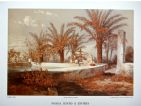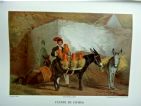En los llanos fértiles susceptibles de ser regados con ayuda de la noria se cultiva también el llamado trigo turco; no sólo sus granos constituyen un sano alimento para el hombre, sino que tallos y hojas son comidos muy a gusto por asnos y mulos. La cosecha de este cereal es muy variable, aunque nunca muy abundante.
 En zonas similares a las descritas se cultiva también la planta algodonera, la cual crece perfectamente en Eivissa. Aunque su cultivo dio mucho mejor resultado de lo que cabía esperar, no se ha extendido mucho, ni se ha atendido de forma constante sino, más bien, en función de las demandas de los mercados continentales.
En zonas similares a las descritas se cultiva también la planta algodonera, la cual crece perfectamente en Eivissa. Aunque su cultivo dio mucho mejor resultado de lo que cabía esperar, no se ha extendido mucho, ni se ha atendido de forma constante sino, más bien, en función de las demandas de los mercados continentales.
En vista del enorme descenso sufrido por el precio del algodón este año (1.868) han sido muchas las plantaciones abandonadas; según parece, pues, la cosecha próxima habrá de ser insignificante.
El tabaco fue cultivado en poca medida en la isla hasta el año 1.866. Las cosechas anuales ascendían a unos 500 quintales como promedio, pero una orden gubernativa puso fin a este cultivo.
 La noria consiste en una rueda vertical que sube el agua contenida en recipientes de barro, madera o de una especie de caña. Las traviesas de aquella engranan con otra rueda, más pequeña, horizontal, provista de una lanza a la que va uncido el animal de tiro. Al describir este sus círculos y girar aquella, la gran rueda vertical mueve los cangilones que se cargan de agua en lo hondo. Las bestias empleadas con este fin suelen ser mulos, aunque no hacen mal avío los asnos, si son fuertes; en cualquier caso, el animal lleva tapados los ojos con dos discos hechos de hoja de palma cuyo objeto es evitar que con tanto voltejeo lleguen a marearse.
La noria consiste en una rueda vertical que sube el agua contenida en recipientes de barro, madera o de una especie de caña. Las traviesas de aquella engranan con otra rueda, más pequeña, horizontal, provista de una lanza a la que va uncido el animal de tiro. Al describir este sus círculos y girar aquella, la gran rueda vertical mueve los cangilones que se cargan de agua en lo hondo. Las bestias empleadas con este fin suelen ser mulos, aunque no hacen mal avío los asnos, si son fuertes; en cualquier caso, el animal lleva tapados los ojos con dos discos hechos de hoja de palma cuyo objeto es evitar que con tanto voltejeo lleguen a marearse.
Archiduque Luis Salvador de Austria. Las Baleares por la palabra y el grabado. Primera parte: Las Antiguas Pitiusas. Ed. Sa Nostra, Caja de Baleares. Palma de Mallorca. 1.982.




















